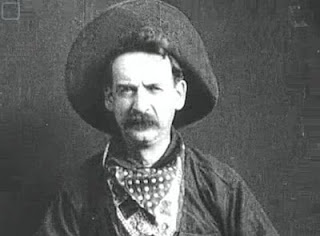In the words of Adolph Zukor, Edwin S. Porter was more of an artistic mechanic than a dramatic artist. This glimpse into the personality and mind of Porter tells us much about the man behind one of the most famous silent films of all time -- “The Great Train Robbery.”
 |
| Edwin S. Porter |
Porter also liked to end his films with, pardon the pun, a bang. In the documentary, “Before the Nickelodeon: The Cinema of Edwin S. Porter,” silent film star Blanche Sweet describes how Porter would borrow “the use of a final punchline from comic strips.” Probably the best-known example of this in Porter’s work is the final scene in “The Great Train Robbery” with the dramatic switch from a long shot to a closeup of cowboy who fires his gun at the viewer. Not only does it serve as a final jolt to the audience, it also breaks the fourth wall and anticipates the use of the closeup for dramatic effect.
It’s difficult to overstate the importance of “The Great Train Robbery” because it was so revolutionary in so many ways. Released in 1903, it helped establish the western as a film genre and it demonstrated how a film could be edited to convey events that are occurring simultaneously. It’s easy to forget how innovative “The Great Train Robbery” was, especially since it uses many techniques that we take for granted today. Surprisingly, Porter failed to realize what was so special about his work. As the documentary and other works on silent film detail, although Porter invented revolutionary techniques, he failed to implement them in subsequent films and failed to break through the constraints of the medium (hence Zukor's quote). In just a few years, Porter’s contributions to film were dwarfed by contributions made by some of the actors that were featured in his films (“Broncho Billy” Anderson, D.W. Griffith), often reducing his name to little more than a footnote in the history of silent film.
 |
| "Broncho Billy" Anderson as a tenderfoot dancer |
You can watch “The Great Train Robbery” in its entirety below.




No comments:
Post a Comment